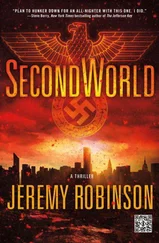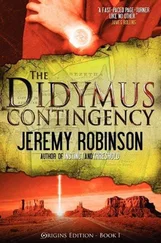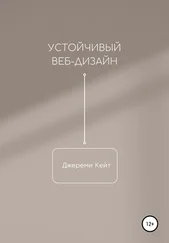Hawkins nodded, but didn’t speak. The three-day deadline wouldn’t give them enough time to cover a lot of ground, but whoever took Kam wouldn’t just be wandering the island aimlessly. That path would end somewhere, and he felt confident they could find out where inside three days. But he had no way of knowing if Kam would still be there when they arrived, or even if he’d still be alive. He did, however, have an idea.
“What about you, Captain?” Hawkins said, looking at the old captain’s bulging muscles. “Let them take the ship out and you help me find Kam.”
A wide grin formed on the captain’s face. “Much as I’d like that, I’m the captain of this ship, and this isn’t Star Trek . My duty is here.”
Hawkins figured as much, but had to ask. While Bray was overweight, Blok a skinny rail of a man, and Joliet not much bigger than a fourteen-year-old boy, the captain was strong and in good shape. They’d cover a lot more ground and he had no doubt that the old sea dog would be good in a fight. Not to mention the fact that he wouldn’t worry about Drake as much as he would Joliet, or even Bray. His relationship with the captain had remained professional. He’d become attached to Bray and Joliet. Their welfare would be a distraction.
“Are these teeth right?” Bray asked, looking up from the drawing.
“Yeah,” Hawkins said. “Why?”
“It had fangs?”
“Yes. Like a snake, but shorter.”
“What about color?” Bray asked.
“Yellow with black stripes,” Joliet answered.
“And you got the size right? It was this slender?”
Hawkins lost his patience with Bray’s rapid-fire questions. “Yes. That’s what it looked like. Do you know what it is?”
“I told you,” Ray said. “That’s a draco.”
Bray stood and turned the pad around so they could all see it. “Your right,” he said to Ray. “But you’re also wrong. The wings are formed by a thin membrane stretched between ribs that the draco lizard can open. But they can’t fly, like a bird. They glide. Usually to escape predators. The wings, limbs, and head are all draco, but the rest… that’s something else.”
“Something else?” Joliet asked.
“You of all people should see it,” Bray said. He propped the sketch pad against his belly. Using both his hands, he covered the creature’s open wings and limbs in the top view Hawkins had drawn. “Remember the coloration. Ignore the size of the head, but take the fangs into account.”
Joliet looked for just a moment before she gasped. “Hydrophis melanocephalus.”
“Hydro-what?” Ray asked.
“A sea snake,” she said, her voice suddenly full of dread.
“That’s bad?” Hawkins asked.
“Sea snakes have the most potent venom of any snake. Far more deadly than any land snake. In fact, it’s the most deadly natural substance in the world.” She looked at Hawkins. “If either of us had been bit…”
“How come we don’t hear about people dying from sea snake bites?” Hawkins asked.
“Because they’re docile,” Joliet said. “You can swim right up and play with them. Millions of years of not being screwed with have made them nice. Probably why their fangs are shorter than the average venomous snake, too. They don’t bite unless severely provoked.”
“Like if you’re trying to eat them,” Bray said. “But just about everything in the ocean knows not to bother.”
Ray looked dubious. “Doesn’t look like a sea snake to me.”
“Nor does it look like a draco,” Bray said. “Because it’s neither. And both.”
“Just what the hell are you talking about, Bray?” Drake asked, raising his voice.
“It’s a chimera,” Joliet said.
The captain didn’t look impressed. “Which is?”
“Two or more creatures merged to form something new,” Bray answered.
“Something unnatural,” Hawkins added. His stomach twisted. There was another word he believed could describe the creature. “Another experiment.”
“I don’t understand,” Hawkins said. “How is any of this possible?”
He lay on his cot, staring up at the ceiling, hands clasped behind his head and feet crossed. Outwardly, he looked no tenser than a vacationer lying in a cot and sipping a mixed drink. But the tension gripping him made his body ache, never mind the fact that the jungle hike, and run, had worn him out. A month on board a ship with less exercise than he was accustomed to had taken a toll on his stamina.
“Which part?” Bray asked. He sat at the room’s only desk, looking at Hawkins’s sketch of the draco-snake, which Bray had dubbed “minidrakes,” by combining “draco” and “snake,” but also because drakes were a type of dragon.
Bray hadn’t used the term in front of Captain Drake yet, but Hawkins had a feeling the man wouldn’t appreciate being associated with the creatures, so he tried to refer to them as chimeras or draco-snakes. “Let’s start with the chimeras.”
After the revelation that the draco-snakes were two creatures merged into one, and likely another experiment, the dinner group had gone silent. Perhaps sensing that a conversation based on the few, but frightening, facts they’d uncovered would lead to wild speculation, Drake had quickly dismissed the group. He asked them to go to bed early so that they might be rested for the search, but Hawkins suspected the dismissal was more for the benefit of the nonscience crewmembers. Their jobs required focus. Worrying about flying lizards and freakish experiments could slow their work, or result in sloppy work, which could endanger all of them in the long run. So they’d returned to their quarters, staying silent for nearly thirty minutes, each lost in thought. Joliet had left, saying she’d needed time to think and process, but she’d come see them soon. She had yet to return.
Bray stood, turned around, and sat back down in the backward-facing chair. “First of all, the idea of a chimera is nothing new. Homer describes a creature in the Illiad that is part lion, part goat, and part snake. The Bible mentions creatures called the Nephilim, which are half-human, half-demon, but then goes on to say that all flesh—including animals—became corrupted. Some people actually believe that the Greek myths, which are full of chimeras, might be based on actual creatures alluded to in the Torah—the first five books of the Bible—as well as the Book of Enoch, an ancient text supposedly written by Noah’s great-grandfather, but not included in the Christian canon. The manticore—part human, part lion, and with three rows of shark teeth. The griffin—part lion, part eagle. The hydra—part serpent, part squid, which might explain its regenerative abilities.”
“But that’s all myth, not reality,” Hawkins said. “Nephilim and hydras might make great fiction, but I can’t take them seriously.” He didn’t care if the pope himself believed chimeras were real. As far as he could tell, myths stayed in the past and he was much more concerned about the present. As much as Bray’s passion and knowledge about history impressed him, thinking about flying lions with shark teeth couldn’t possibly help him understand the draco-snakes.
“Okay, let’s talk science.” Bray rubbed his chin for a moment, collecting his thoughts. “First, it’s important to understand that chimeras can form naturally.”
“C’mon,” Hawkins said, fearing that Bray was about to make a case for the reality of mythological chimeras.
“Just listen,” Bray said. “Chimeras are formed when two fertilized eggs, or embryos, fuse in the womb. I’m not talking cross-species chimeras here. A chimera can develop from a single species if two distinct embroyos become one.”
Читать дальше












